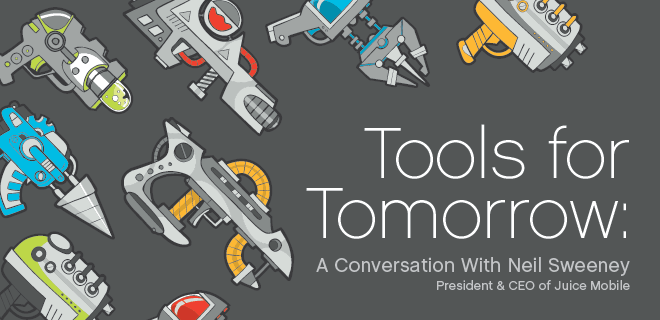
For publishers, mobile is an itch spreading over greater sections of skin, tingling more ferociously every second. Scratching doesn’t make it worse, but certainly fails to relieve the symptoms.
Publishers continue to struggle in their mobile monetization efforts: because there’s little incentive for direct sales to evangelize the channel (particularly when it comes to display), programmatic would seem to be the savior. However, the success of desktop advertising and transaction models ported to mobile has been limited.
Fortunately, mobile is still a young space, filled with opportunities for innovation – it’s a prime time for publishers to embrace new tools and advertising units. As JUICE Mobile CEO and President Neil Sweeney puts it, “today’s methodologies and ad units will not be tomorrow’s.”
In this sweeping interview, Sweeney explains how mobile inventory has already been commoditized, the limitations of programmatic tools that don’t cater to advertisers, and why being mobile focused and having no legacy online business is an advantage for a provider. Oh, and we dive a bit into wearables and the connected-device frontier.
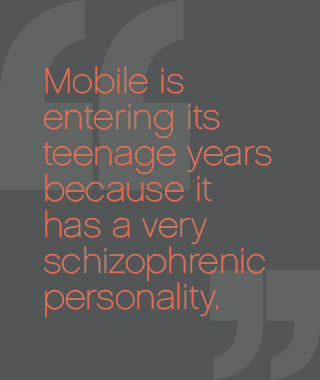 Gavin Dunaway: You suggest that, “mobile has entered its teenage years.” That’s a great phrase, but what does it mean?
Gavin Dunaway: You suggest that, “mobile has entered its teenage years.” That’s a great phrase, but what does it mean?
Neil Sweeney: Having been in the mobile space for what feels like dog years, one thing we’ve seen that’s not necessarily specific to mobile is that every medium has aped its parent medium. We saw it with online, which first embraced a lot of the methodologies of traditional newspaper. It’s natural that after 2007, with the explosion of applications and the need to monetize those applications, you’re going to turn to the methodologies that people already understand. Mobile took on traditional display because that’s what everybody was buying already.
Especially with the rise of programmatic, we’re deriving as much efficiency out of those traditional avenues as possible. Now that we have achieved a level of parity with display it is natural that people are looking to find efficiency with these ad units and RTB allows for this to happen. Once you have rung all of the efficiency out of the ecosystem, which is happening at a rapid pace, the question is – now what? The market is turning inwards on itself, saying, “All right – these phones have evolved considerably over the last couple years… Maybe we should start embracing the utility of the device itself a little bit.”
So I say that mobile is entering its teenage years because it has a very schizophrenic personality. Pretty much every plan still incorporates traditional display, but we’re already starting to see brands embrace native, rich-media and custom-built units. That’s what brands will be looking for in the future. If mobile is going to evolve to a world that includes wearables and other connected devices, brands are going to be jumping back and forth from what they’ve done in the past and what mobile is becoming.
GD: So where does JUICE Mobile fit in this picture? What was the impetus to launch the company four years ago?
NS: My previous company dealt a lot with brands and publishers who were struggling with the introduction of these super-powered phones. I use the example of the innovator’s dilemma all the time: if your core business is online, television or traditional advertising, how are you going to find the time to become an expert in a medium (mobile) that represents a small piece of your overall business, but is growing much faster than all the other parts?

A lot of firms have gotten into the habit of taking a pre-existing methodology and porting it to a new technology. Even four years ago, I never wanted to be burdened by the legacy of older media. I wanted to create new solutions for new technology and new problems, as opposed to taking old technology and applying it to those problems. By forming the company four years ago to focus exclusively on mobile, not only did we help educate brands, but we also allowed them to look holistically through a mobile lens.
GD: What do you think is a publisher’s biggest pain point in selling mobile inventory today?
NS: Oh, there’s a lot, but the biggest one is environment. There hasn’t really been a solution embracing environment as a variable in advertising campaigns. A lot of the tools and technology are very audience-based, and there’s tons of value in doing that. But premium publishers have huge infrastructure costs… and have to compete with standalone blogs without the acknowledgement of those costs and their huge voice in the market. They’re having to trade at a steeply discounted value because there’s way too much inventory.
Somewhere along the line everybody became convinced environment didn’t matter. And I have always had a tough time with that, mainly because consumers make decisions based on environment and brand every single day. There’s been such a fixation on price that people have been buyingcheap inventory without acknowledging that there is value in the brand.
But there is no value in environment when it is trading fifteen times more than anybody else and it’s under-performing. No one’s expecting you to buy premium even though it’s more expensive and under-performing. That’s ridiculous. But there’s a lot of premium stuff that performs equally well as remnant inventory, and the reason people don’t buy it is entirely based on price and accessibility. If you can actually close the gap on these two things, buyers would be more willing to buy from a top, premium publisher with millions of daily impressions. That’s been a real challenge in the market across the board, and nobody’s solving it.
GD: Is mobile the channel where advertisers will increasingly take context and environment into account when buying?
NS: I don’t necessarily think that it’s mobile. The challenge in the digital space is the tools. You’re not dealing with as well-established tools in mobile as you are in online. It’s possible to try to turn the big online engine around by introducing a whole new set of tools, and huge companies are spending millions upon millions of dollars doing it one way. To try to introduce an entirely new way of doing things in that model, which has so much momentum, you’re swimming upstream.
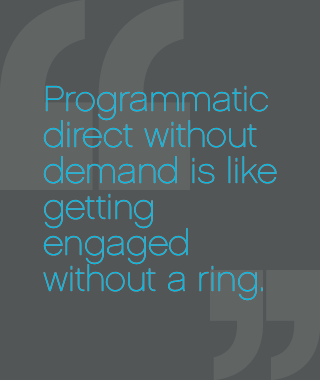
Opportunity exists as those same online firms are not doing as well in mobile, because they suffer the innovator’s dilemma and they’re in a hyper-competitive space. For them to completely pivot to embrace a new model in mobile is not the way to go. This is the challenge – we are using online tools to solve mobile problems.
When I look at mobile, I think here is an environment where there’s an opportunity for new companies, new waves of thinking, new tools to be introduced because in this market, people aren’t set on what tools they’re going to be using. So I guess it’s less about mobile itself as a medium and more about mobile being a relatively new medium with opportunities for new ways of thinking in that space.
GD: Do you think the desktop programmatic model, particularly the auction segment, is not as effective on mobile?
NS: It’s not that the traditional online model doesn’t work for mobile. There’s tons of value in buying mobile in a real-time environment, assuming that your execution and what you’re trying to achieve from your advertising campaign mimics what you’re trying to do in a real-time environment. The challenge is that programmatic model is based on, “Hey, let’s drop a cookie or a pixel, and let’s re-target towards that based on the specific audience that we’re looking to buy.” You can’t do that in mobile the same way – it’s basically trying to drive a car with no brakes.
GD: So how does JUICE Mobile offer a new approach?
NS: When we launched Nectar™ two years ago at Mobile World Congress in Barcelona, the idea was not to reinvent the DSP – but rather provide something that was missing in the ecosystem. What we wanted was a platform that increased efficiency across the board but also put more control and personalization into the process – not only for publishers, but for advertisers as well.
Programmatic direct has done a reasonably good job of solving some of those efficiency challenges for publishers, but it hasn’t necessarily done as good a job at solving those efficiency challenges for the advertisers. Things like inventory discovery, historical performance, targeting, multiple ad formats – and matching those against publishers are huge gaps in the market. These are things that every major buyer in a major agency is struggling with every day when they want to buy mobile. Who can take my $50,000? Who has inventory? How much? What format? How has this performed historically?
At its core, Nectar™ is about re-empowering publishers and advertisers to take control of their advertising inventory and buying, and implement their own beliefs as to where there is value, while also seeing all of the performance and metrics needed to make intelligent decisions.
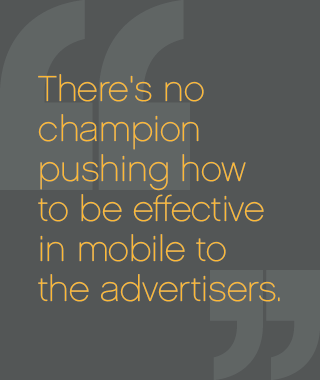 GD: It’s interesting that you think programmatic direct platforms aren’t meeting advertisers’ needs. Is that why demand has been sluggish on this channel?
GD: It’s interesting that you think programmatic direct platforms aren’t meeting advertisers’ needs. Is that why demand has been sluggish on this channel?
NS: Programmatic direct without demand is like getting engaged without a ring – it doesn’t work. At this point, current businesses are just integration platforms with no dollars attached to them. Good luck with that. Where programmatic direct has gone wrong is that it’s really fixated on the supply side without a whole lot of visibility onto the demand side. As a business, we’ve always dealt with both sides, so we have very good visibility into the processes and the methodologies for the demand side, as well as those for the publisher’s side Building technology and platforms that allow those two to interact and engage with one another creates a ton of volume.
The other thing I would say about programmatic direct is that there’s not enough scale. It’s great that you’re a one-off publisher that’s using a one-off solution, but if your programmatic direct provider has 10 publishers in their solution, the buyers don’t have time for that especially if you are not educating them on how it works. Advertisers are short on time – which is part of the rationale as to why RTB, and networks before them, were so successful. They provided scale. For programmatic direct to work, advertisers will need to go into a solution where there are 250 publications with dynamic pricing that they can pick and choose from. No self-respecting buyer is buying rate-card off of a publisher when they’ve got any sizable amount of budget regardless of the efficiency you provide to them.
GD: Publishers also have a great deal of trouble garnering advertiser demand for their mobile inventory. How does JUICE Mobile drive demand to mobile?
NS: Publishers are having trouble driving demand to their mobile channels because they’re trying to sell mobile using their online sales team. Sales teams are driven to make budgets, plain and simple. An online sales rep trying convince a buyer that is not savvy in mobile to spend part of their budget is not the best use of their time. More often than not, it’s easier for them to continue to push desktop, which typically represents 90% of the digital budget, whereas mobile represents 10%.
There’s no champion pushing how to be effective in mobile to the advertisers. The advertisers are also in that situation – they’re representing their car company, they’ve got about a million RFPs to send, then they have to pivot on to the next brand. They don’t have time to figure out a completely new way of doing things.
How we drive demand is we don’t spend time in online. It’s our belief that the entire media world is pivoting to mobile, and that anything outside of that is legacy, and that includes desktop. I dont want to solve yesterday’s problems – desktop’s problems. I want to solve a future problem. So when we go into the Unilever’s or the P&G’s of the world, we talk specifically about how to be effective in mobile, how to use technology to be effective in mobile, how to differentiate mobile and how to layer in different pathways to get a better method. I think that’s a huge gap in the market, and I think that’s what has really resonated.
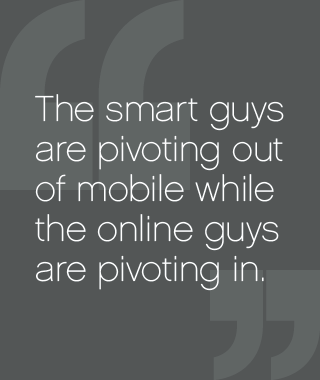 GD: We briefly touched on wearables – what kind of effect will widespread consumer adoption of wearable technology as well as connected devices have on mobile advertising, as well as advertising in general?
GD: We briefly touched on wearables – what kind of effect will widespread consumer adoption of wearable technology as well as connected devices have on mobile advertising, as well as advertising in general?
NS: Oh, I love this question. When you’re looking out your window and you see that huge cloud on the horizon? That’s the wearable cloud, that’s the connected home, that’s the connected car. The smart guys are pivoting out of mobile while the online guys are pivoting in. When we talk about mobile entering its teenage years, it’s an acknowledgement that today’s methodologies and ad units will not be tomorrow’s.
Look at how mobile has evolved: TV to desktop, desktop to laptop, laptop to tablet, tablet to phone. All of those have a screen. The ability for a major brand to trickle down to the next medium has been okay because there’s always been a screen. Well, when you introduce things like wearables – where there is no screen, physical keyboard or similar things – you’re talking about a fundamental shift in how to communicate your message. I don’t think any Fortune 500 company out there has any understanding as to how they’re going to get their head around that.
Historically, your phone has been something that you used to make a call. Now, it’s something that’s used to consume content, but still resides in your pocket. In the future, your phone is going from your pocket to your wrist – which is where we are now – to going in your body. My feeling is that the wearable is the precursor to the embeddable. That’s a bit sci-fi for everybody.
How are the advertising models which we’ve spent 50, 60, 70 years developing going to change to reflect that when they’re barely keeping up with the pace of innovation today? Only the companies that are fixated or focused on the ecosystem at hand are going to be successful. If you’re trying to pivot over to mobile from desktop or newspaper, getting your head wrapped around the future state of mobile is going to be really tough.
And that’s why I think the smartest mobile guys in the space are the guys that are already playing around with some of this emerging technology. We’re very much doing that because it’s kind of our job to be out on the edge, to point brands in the direction that the future is heading.